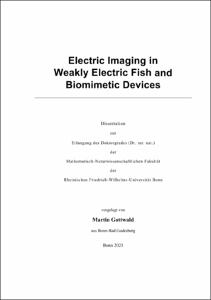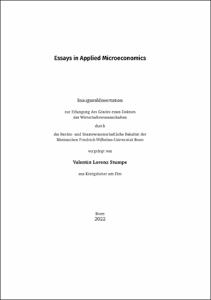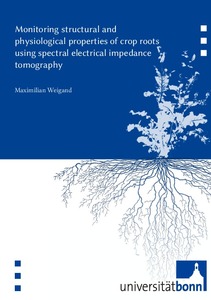Gottwald, Martin: Electric Imaging in Weakly Electric Fish and Biomimetic Devices. - Bonn, 2022. - Dissertation, Rheinische Friedrich-Wilhelms-Universität Bonn.
Online-Ausgabe in bonndoc: https://nbn-resolving.org/urn:nbn:de:hbz:5-67434
Online-Ausgabe in bonndoc: https://nbn-resolving.org/urn:nbn:de:hbz:5-67434
@phdthesis{handle:20.500.11811/10148,
urn: https://nbn-resolving.org/urn:nbn:de:hbz:5-67434,
author = {{Martin Gottwald}},
title = {Electric Imaging in Weakly Electric Fish and Biomimetic Devices},
school = {Rheinische Friedrich-Wilhelms-Universität Bonn},
year = 2022,
month = aug,
note = {The nocturnal and weakly electric fish Gnathonemus petersii inspects its murky habitats by self-generated electric signals; an adaption called active electrolocation, enabled by the fish's active electric sense. Animals, plants or stones it encounters modulate the fish's emissions, evoking electric images across its electroreceptive skin. Yet, the cues G. petersii derives from these images to determine prey and other relevant organisms remain unknown. Revealing and verifying them experimentally as well as adapting them, along with others, for bio-inspired devices were the two goals of this thesis.
The electric image recordings and behavioral assays presented in the thesis' first two studies show that the fish primarily identifies its invertebrate prey via 'electric colors'. These cues also allow G. petersii to recognize weakly electric or other fishes and plants. According to the recording results, the fish may further judge some organisms by their 'electric brightness', which is also supported by previous behavioral data. Given the findings above, it can be assumed that besides G. petersii many other species of weakly electric fish do sense electric colors and thereby occupy their nocturnal invertebrate-feeder niche. On a broader scope, these color-like cues, determined in an active electrosensory system, suggest 'color' perception as a sensory concept beyond vision and passive sensing.
In the thesis' two final studies, prototypical versions of either an 'electric camera' for object inspections in murky waters or a low-cost catheter system to diagnose atherosclerotic plaques in coronary arteries were developed and tested. Like the fish, they analyze their targets via simple electric image parameters, i.e., electric colors and relative slopes – depicting image blurring – (in the electric camera) or image peaks and rel. slopes (in the catheter system). In doing so, the camera prototype was able to identify nearby fish, plants or metal and plastic objects and to infer object distances. It could also gauge the targets' basic shapes via 'electric outlines' – a novel image cue –, which, in turn, might also be used by G. petersii to estimate a target's geometry and orientation. The catheter system did detect and determine individual types of synthetic plaques, mimicking real low-to-high-risk ones. As suggested by these two successful proofs concepts, mature versions of the devices above should have the potential to improve medical and industrial routines. The use of inexpensive electrolocation catheters, in daily clinical practice, could significantly enhance, the otherwise costly and thus limited, identifications of high-risk plaques along with the chance of preventing their fatal complications in various patients. On the other hand, in increasingly relevant food industries like aquacultures the electric camera could detect damaged net cages, anytime without any sort of lighting, which would save fish stocks without disturbing them.},
url = {https://hdl.handle.net/20.500.11811/10148}
}
urn: https://nbn-resolving.org/urn:nbn:de:hbz:5-67434,
author = {{Martin Gottwald}},
title = {Electric Imaging in Weakly Electric Fish and Biomimetic Devices},
school = {Rheinische Friedrich-Wilhelms-Universität Bonn},
year = 2022,
month = aug,
note = {The nocturnal and weakly electric fish Gnathonemus petersii inspects its murky habitats by self-generated electric signals; an adaption called active electrolocation, enabled by the fish's active electric sense. Animals, plants or stones it encounters modulate the fish's emissions, evoking electric images across its electroreceptive skin. Yet, the cues G. petersii derives from these images to determine prey and other relevant organisms remain unknown. Revealing and verifying them experimentally as well as adapting them, along with others, for bio-inspired devices were the two goals of this thesis.
The electric image recordings and behavioral assays presented in the thesis' first two studies show that the fish primarily identifies its invertebrate prey via 'electric colors'. These cues also allow G. petersii to recognize weakly electric or other fishes and plants. According to the recording results, the fish may further judge some organisms by their 'electric brightness', which is also supported by previous behavioral data. Given the findings above, it can be assumed that besides G. petersii many other species of weakly electric fish do sense electric colors and thereby occupy their nocturnal invertebrate-feeder niche. On a broader scope, these color-like cues, determined in an active electrosensory system, suggest 'color' perception as a sensory concept beyond vision and passive sensing.
In the thesis' two final studies, prototypical versions of either an 'electric camera' for object inspections in murky waters or a low-cost catheter system to diagnose atherosclerotic plaques in coronary arteries were developed and tested. Like the fish, they analyze their targets via simple electric image parameters, i.e., electric colors and relative slopes – depicting image blurring – (in the electric camera) or image peaks and rel. slopes (in the catheter system). In doing so, the camera prototype was able to identify nearby fish, plants or metal and plastic objects and to infer object distances. It could also gauge the targets' basic shapes via 'electric outlines' – a novel image cue –, which, in turn, might also be used by G. petersii to estimate a target's geometry and orientation. The catheter system did detect and determine individual types of synthetic plaques, mimicking real low-to-high-risk ones. As suggested by these two successful proofs concepts, mature versions of the devices above should have the potential to improve medical and industrial routines. The use of inexpensive electrolocation catheters, in daily clinical practice, could significantly enhance, the otherwise costly and thus limited, identifications of high-risk plaques along with the chance of preventing their fatal complications in various patients. On the other hand, in increasingly relevant food industries like aquacultures the electric camera could detect damaged net cages, anytime without any sort of lighting, which would save fish stocks without disturbing them.},
url = {https://hdl.handle.net/20.500.11811/10148}
}









